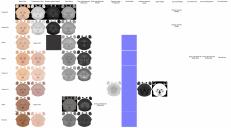Best skins for Blender?
 camilo
Posts: 20
camilo
Posts: 20
Which skins work better in Blender? I've already seen some posts about the best skins on this forum, but the question has been geared toward which ones work best in Daz and I'm not sure if the ones that give the best results in iRay are also the best for Blender.
I have had mixed results with the skins I have purchased and realized that I understand very little about how they work in Daz. I compared the maps of some of the skins to understand the differences (see attachment) and would also like to know which maps are more important to get more realistic results in Blender. I'm thinking about mixing maps to get variety, but I'm not sure if it will work.
Additionally, which skin parameters are more critical to tweak to get better results? One of the problems I'm having is that some materials that work well with diffuse lighting indoors don't work so well with direct light outdoors, so I'd like to know which parameters I should pay more attention to. I'm only working in Cyles for now.
Thanks




Comments
The best option you have is to get a custom skin shader for blender. Otherwise you can use the principled shader and fine tune the textures there. As for diffeomorphic the bsdf option will try to import the iray materials and usually does a good job, but the materials in blender will then have the same issues they have in iray that you commented about.
My personal opinion is that most daz PAs are very "creative" when it comes to materials especially for skins, and rarely they follow the pbr rules that are also explained in the uber shader docs. Since iray is very flexible and allows for non-pbr materials this results in a mess with daz materials in general.
https://blendermarket.com/products/real-skin-shader-v2
Interesting shader. Can you recommend something similar for Cycles?
I bought this one https://blendermarket.com/products/dermis-shader. I'll report as soon as I test it.
Thanks! I'm interested in the results.
Was going to advice dermis myself, not that I use it but the concept seems very good.
I've spent a lot of time experimenting with skin in Cycles and Renderman. I'll throw out my opinions in an effort to help save you some time and money but I admit that I never got skins to look awesome in Cycles. If you take a gander at Artstation and look at the most realistic portraits, you'll see mostly Arnold and Unreal. I played around with Renderman and got good results but it is so complex I didn't want to put any more time into trying to learn it and get better at it. I've since switched over to Unreal. There are some good studio renders in Cycles, but I haven't really seen any in an environment with real world lighting. I'm sure there are some out there somewhere.
I don't think anyone uses the 3-layer system the dermis-shader is promoting. If you check out the video below, this artist is using Arnold in Maya (17:16 to about 18:50). One skin layer with correct SSS depths for red, green, and blue, and the correct scale. I think the old cycles shader I used was set up just like the video; sss depths were set to red=1, green=.33, and blue=0.20. Subsurface was set to a value of 1 and diffuse was set to 0. I put a big spotlight behind the character's head and adjusted the scale until I saw the ears glow the color red that I liked. I can dig up a shot of my node setup if you want it.
I agree with Padone 100% that the DAZ materials are optimized for DAZ and unfortunately need some work when being used anywhere else (blender, maya, unreal, etc). One way to adjust is to take a DAZ skin and adjust the color using the method in the video below. The target skin color can be a real life photo, a skin from the 3dscanstore.com, or search for 'Pantone skins' and experiment with those colors. This might get you closer to real world skin tones and then you can adjust further in Blender.
Hope this helps a little bit.
ps, the reason I posted a video using maya and arnold was because the dermis-shader advertises that their shader system is based on Arnold somehow. Arnold does not use a 3 layer system as far as I know and that is what I was trying to illustrate. I think all the big engines use a similar setup which is in the video I posted.
Thanks for the information. There are so many options for making skin with Cycles and everybody seems to take a different approach. I'm aware that doing realistic skin in Cycles from Daz figures requires some extra work. My goal is to take the Daz figures and textures as base for modification in Photoshop and Blender.
I found some ideas for baking details in this tutorial. They do characters from scratch but this tutorial is not free. Nevertheless I learned some things about pores, wrinkles and peach fuzz, as well as hair.
I still have to digest it.
I also found this video interesting about the future of the Principled shader and the explanation about the purpose of the actual one.
Arists tend to use the shader in their way, without really knowing what the implementers intended. We will come to a certain degree of realism, but I also try to create a set of assets to tell stories and define a personal workflow and I always have to keep myself from always trying to be perfect.
By the way, Krys, you tutorials for Diffeo have been a great help and Padone does an awesome job as well. Thanks to both of you and of course to Thomas for the plugin.
Photorealism is the holy grail, but I'm looking mostly for a compromise between realism and easy workflow that give me a decent result. I have no plans to move from Cycles because I feel comfortable with it and I don't want to spend time learning other render engines.
Krys, I watched the same video you shared for adjusting colors and I already used that method to fix renders with different results according to the light setup. That's why I'm asking about the best skins to work in Blender and which ones you recommend that need fewer adjustments at the end. Or are you talking about doing those adjustments directly into the diffuse texture map before rendering? Also, I'll be happy to see your node setup.
Singular3D, I'm also interested in that course and probably I'll buy it at some point, but mostly to learn tricks instead of doing my own characters from the ground. Could be also useful for hair, the ones from Daz look ugly and don't work well in Blender.
I think we are on the same page here. I do not want to create characters from ground up myself, but enhance the imported Daz characters. Human shows, how multires sculpted details can be baked into displacement maps. They also show, how details like pores can be added and how a noise texture helps to make the skin even more realistic. There is a lot of stuff there as well that I do not need in near future.
Just had a look at the Hyperrealistic Rendering tutorial (provided by Krys) and that was quite inspiring as well.
I plan to document my workflow, when I'm satisfied with it, to a certain degree. Will probably take till beginning of 2023. Maybe I can share some early findings though in December.
I hope to see your workflow soon. I just tested the Dermis Shader with Daz textures and tried to tweak it a bit but the result is horrible, I need to invest more time to see if there is a way to use Daz textures with that shader, I don't want to invest money buying textures from 3dscanstore. For now, I'll put that shader aside and I'll continue doing tests with the Diffeomorphic materials, results with version 1.6.2 are promising, I only used version 1.6.1 until now. I posted those tests here https://www.daz3d.com/forums/discussion/604576/testing-diffeomorphic-1-6-2-materials-and-tone-mapping
Saw that post. Quite interesting. I'll have a look at that too.
did anyone find a way to make good skin in blender?